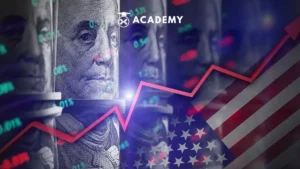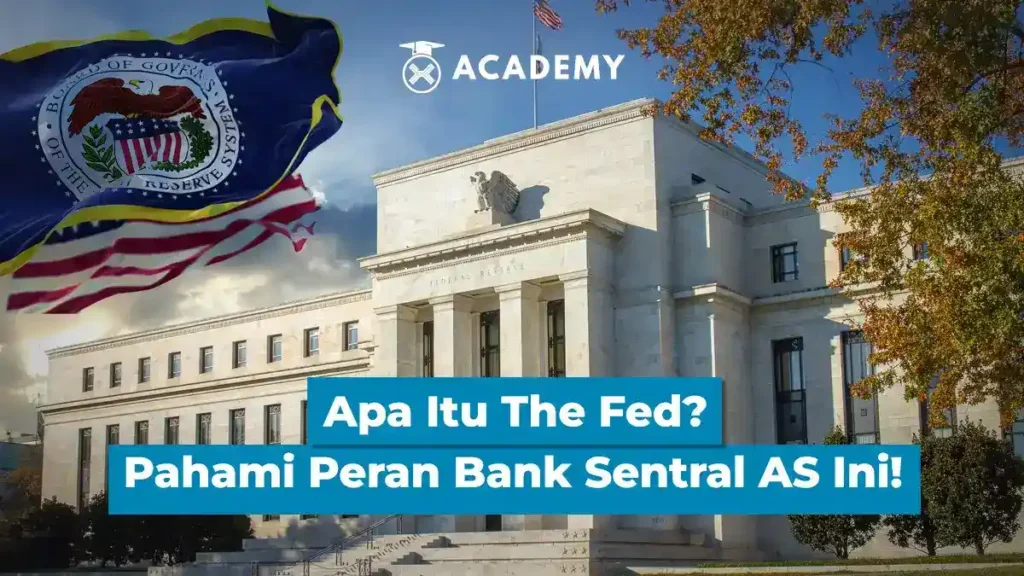The Fed, as the central bank of the United States (US), is the most influential banking institution in the world with a broad global impact.
In addition to focusing on domestic economic stability, the Fed also acts as an emergency lender in dollars to other central banks around the world, and influences global monetary conditions.
The policies implemented by the Fed can cause large capital movements and asset price fluctuations at the international level.
What is the Federal Reserve?

The Federal Reserve, more commonly known as “The Fed,” is the central bank of the United States and the highest financial authority behind the world’s largest free-market economy. The Federal Reserve is headquartered in Washington, D.C.
Given the United States’ immense influence on the global economy, “The Fed” is considered one of the most influential financial institutions in the world.
The Federal Reserve conducts monetary policy independently of the government without legislative interference.
In addition, the Fed also performs a variety of other central bank functions, such as regulating banking activities, conducting surveys of the U.S. and global economies—all with the primary goal of maintaining financial stability.
History of Its Establishment
The Fed was born indirectly due to the “Panic of 1907” and the overall economic situation at that time. The last quarter of the 19th century and the beginning of the 20th century were marked by recession in the US economy.
A series of financial panics forced prominent bankers such as J.P. Morgan and John D. Rockefeller Jr. to call for the establishment of a new central banking system.
The country’s dire financial situation then prompted Republican Senator Nelson Aldrich to form two separate commissions to study the American monetary system and central banking institutions in Europe.
Aldrich was greatly inspired by the Bank of England model and the German monetary system. Although his initial proposal was repeatedly rejected by Congress, a revised bill was finally passed on December 22, 1913.
The Fed’s Main Functions
The Federal Reserve is the central bank of the United States and is therefore responsible for maintaining the overall economic stability of the country. Here are some of the main functions of the Fed.
Also Read: What is Monetary Policy? Here’s the Definition & 5 Examples!
1. Implementation of monetary policy
Through monetary policy, the Federal Reserve seeks to achieve three primary goals set by Congress: maximum employment, stable prices, and low long-term interest rates.
The Fed controls inflation, investment, and other economic parameters by regulating the availability of credit in the economy.
2. Maintaining the stability of the financial system
The Federal Reserve ensures the stability of the U.S. financial system, monitors internal and external influences, and prevents future crises.
3. Regulating financial institutions and their activities
The Fed oversees the activities of financial institutions and controls their impact on the economy as a whole.
4. Supporting the security of the payment and settlement system
The Federal Reserve seeks to ensure a secure and frictionless payment system for the benefit of American citizens.
5. Protecting consumer rights
Consumer rights are an essential component of the financial services sector, and the Federal Reserve works continuously to ensure these rights for all consumers.
The Fed Structure
The Federal Reserve as a central bank is a multi-tiered financial institution that derives its authority and basis from the Federal Reserve Act of 1913.
Although it is an executive agency, it is largely independent of both the President and Congress and is described as “independent within the government.” The four main axes of power of the Federal Reserve include the following.
1. Board of Governors of the Central Bank
The seven-member Board of Governors is responsible for overseeing the overall functioning of the monetary institution as a central bank, including managing the activities of 12 regional banks, formulating monetary policy, and overseeing the economy in general.
Each member of the Board is appointed by the President for a 14-year term, while the Chairman and Vice Chairman are appointed by the Board for 4-year terms. Currently, three of the seven seats on the Board are vacant.
Also Read: How Does the Federal Open Market Committee (FOMC) Affect Financial Markets?
2. Federal Open Market Committee (FOMC)
The Federal Open Market Committee (FOMC) is the committee responsible for managing open market operations, which are an important component of monetary policy.
The committee consists of 12 members, including all seven members of the Board of Governors and the Presidents of the five regional banks.
The representatives of the regional banks are elected for two- to three-year terms, while the President of the Federal Reserve Bank of New York is a permanent member.
3. Regional Federal Reserve Banks
The 12 regional Federal Reserve banks are responsible for implementing the monetary policy set by the Board. Each bank has a board of nine members and is headed by an in-house President.
In addition to its regulatory role, each bank also conducts its own operations, including holding securities and making loans.
4. Other Member Banks
Member banks are private financial institutions that own shares in the regional Federal Reserve banks, which generate profits from those shares.
The banks receive a 6% dividend from the profits they earn from their shares, while the rest of the profits are deposited into the U.S. Treasury.
Fed Monetary Policy
The monetary policy implemented by the Fed aims to achieve two main goals, namely maximum employment and price stability.
By controlling interest rates and credit availability, the Fed influences economic activity, especially public demand for goods and services.
By setting interest rate targets and regulating the amount of money in circulation, the Fed keeps the economy growing without causing excessive inflation.
On the other hand, changes in interest rates made by the Fed have a significant impact on the economy.
If interest rates are lowered, credit becomes more accessible and cheaper, encouraging investment and consumption, which in turn increases economic growth and employment.
Conversely, if interest rates are raised, credit becomes more expensive so that people and businesses tend to reduce spending and investment. This suppresses inflation, but can slow economic growth.
By regulating credit availability, the Fed can maintain a balance between healthy economic growth and stable inflation.
Also Read: Digging into the Causes of Inflation: Why Prices Keep Rising
The Fed’s Global Influence

Fed policy has a major impact on the global economy, primarily through interest rate changes that affect international capital flows.
When the Fed raises interest rates, dollar-denominated assets become more attractive, driving capital into the U.S. and often weakening currencies and financial markets in other countries.
For example, Fed rate hikes often put downward pressure on emerging market currencies as investors pull money back into the U.S.
That can trigger volatility in those countries’ stock and bond markets, which in turn complicates local economic conditions.
Conclusion
Well, that was an interesting discussion about What is The Fed? Understand the Role of This US Central Bank! which you can read in full at the Crypto Academy at INDODAX Academy.
In conclusion, The Fed has a very important role in maintaining the stability of the United States economy and has a significant impact on the global economy.
Through its monetary policy, The Fed regulates interest rates and credit availability, which directly affect economic growth, employment rates, and inflation domestically.
This policy also has an impact on international capital flows and currency exchange rates, thus affecting the economies of other countries.
Given the complexity and interconnectedness of the global economy, understanding more deeply about the impact of The Fed’s monetary policy is very important.
Not only is it relevant for economists and market players, it is also for the general public who want to understand how decisions made in Washington can affect everyday life and economic stability around the world.
FAQ
1. What is the Federal Reserve?
The Federal Reserve, or The Fed, is the central bank of the United States responsible for monetary policy and financial stability.
2. What is the history of the founding of The Fed?
The Fed was established in 1913 after the “Panic of 1907,” which demonstrated the need for a central banking system to maintain financial stability.
3. What are the main functions of the Fed?
The main functions of the Fed include implementing monetary policy, maintaining the stability of the financial system, regulating financial institutions, and protecting consumers.
4. What is the organizational structure of the Fed?
The Fed consists of the Board of Governors, the Federal Open Market Committee (FOMC), 12 regional Federal Reserve banks, and other member banks.
5. How does the Fed affect the global economy?
Monetary policies implemented by the Fed, such as changes in interest rates, can affect economies around the world, including investment and capital flows.





 Polkadot 8.92%
Polkadot 8.92%
 BNB 0.40%
BNB 0.40%
 Solana 4.83%
Solana 4.83%
 Ethereum 2.37%
Ethereum 2.37%
 Cardano 1.35%
Cardano 1.35%
 Polygon Ecosystem Token 2.12%
Polygon Ecosystem Token 2.12%
 Tron 2.85%
Tron 2.85%
 Market
Market


